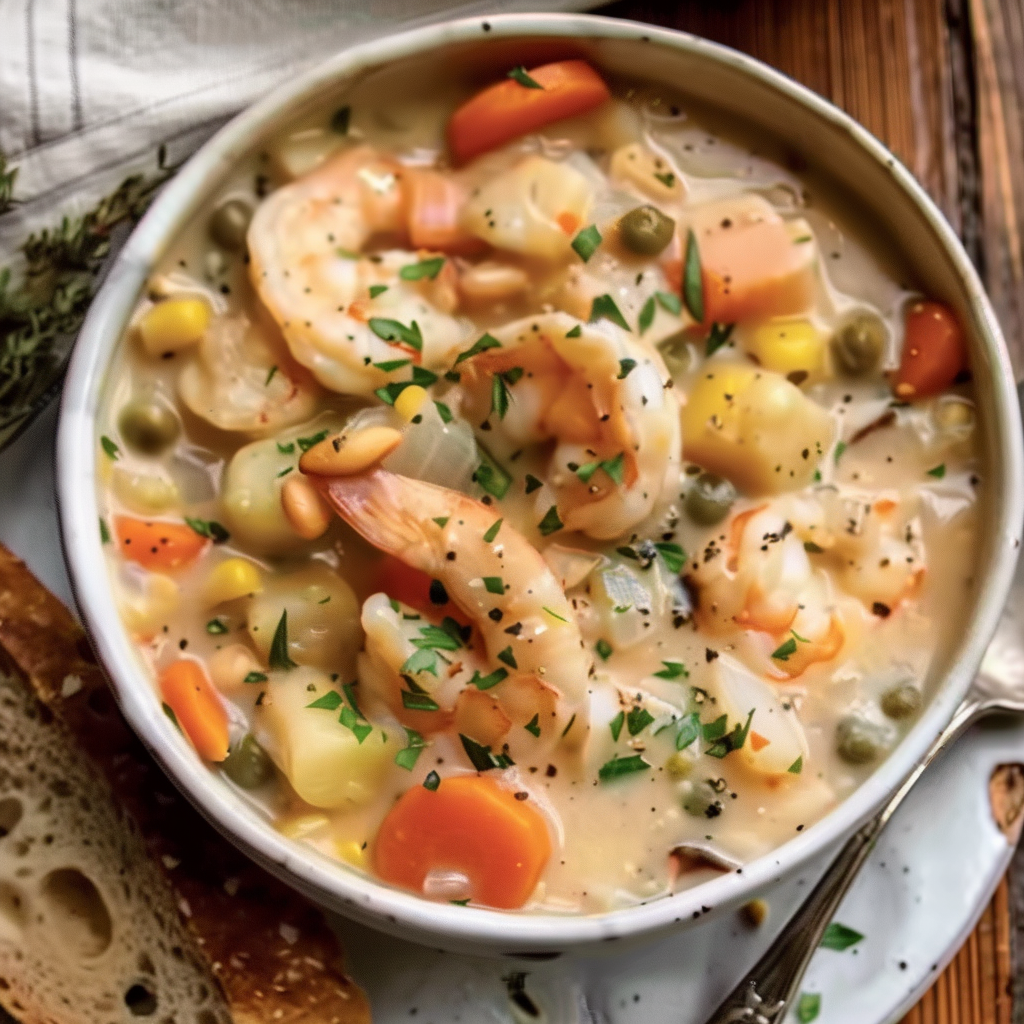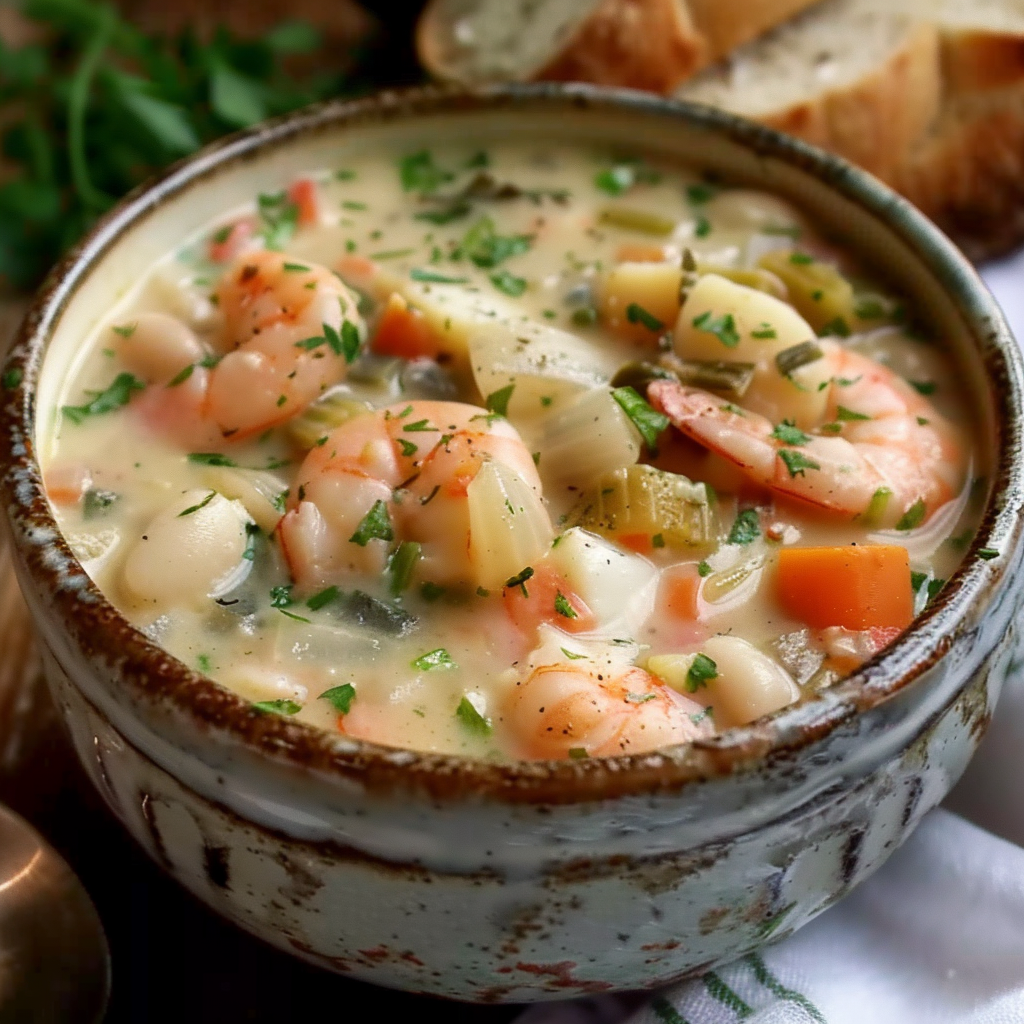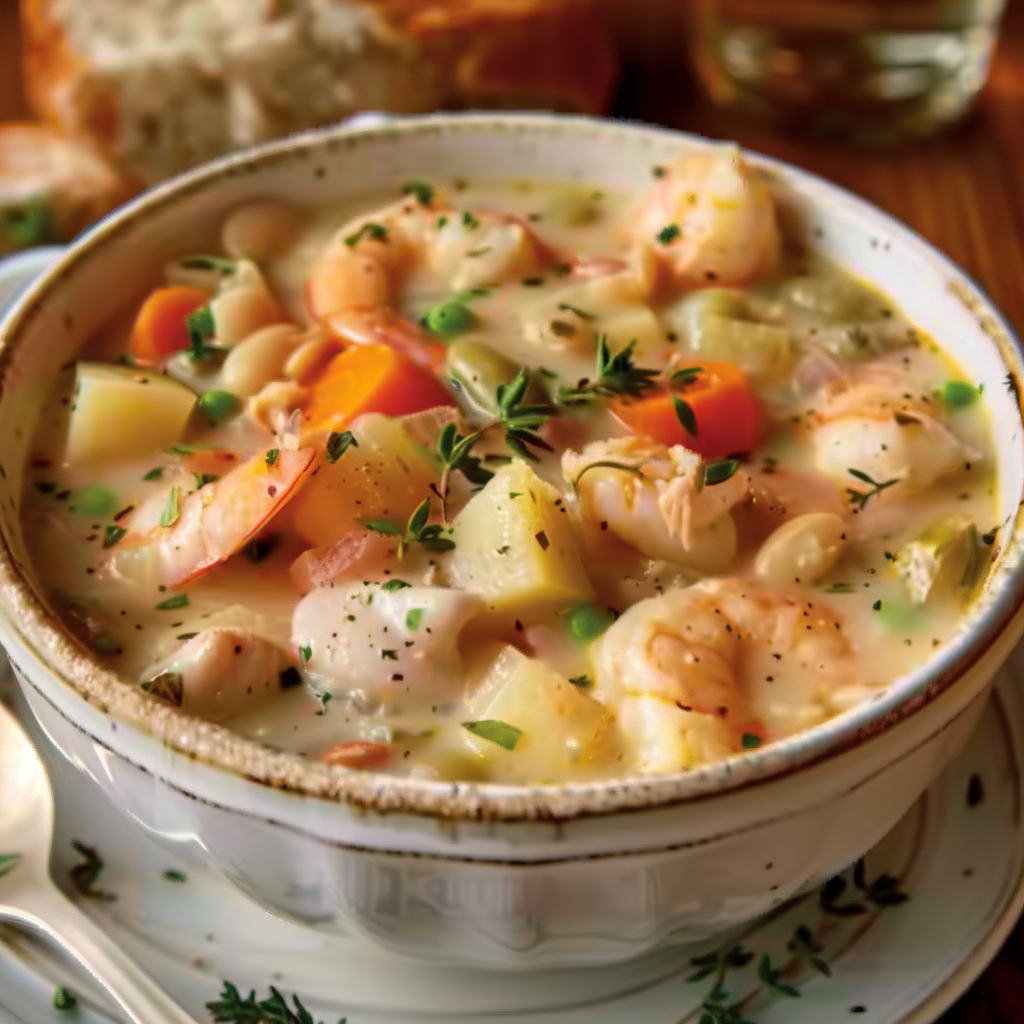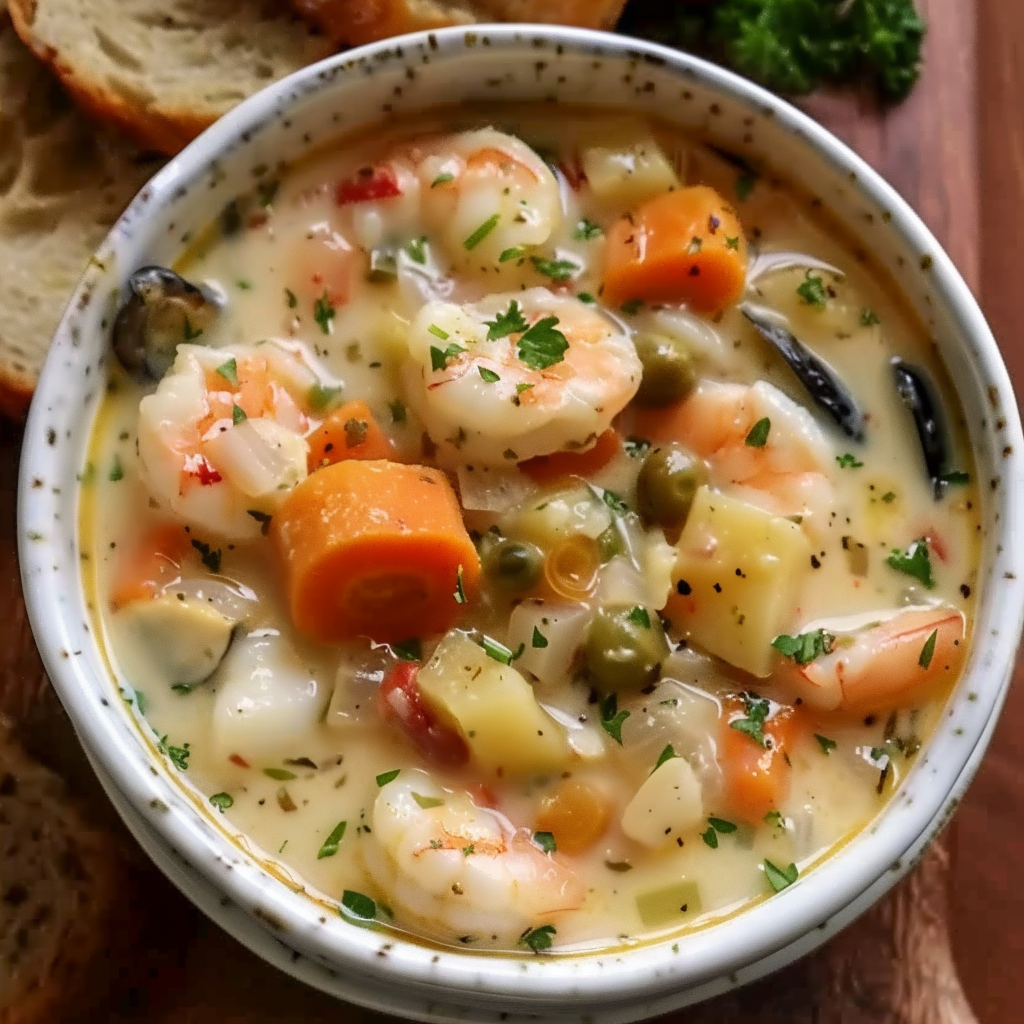New England-Style Seafood Chowder
When it comes to comfort food that warms the soul, few dishes can compete with a bowl of creamy New England-style seafood chowder. Known for its rich, velvety texture and abundance of fresh seafood, this chowder is a beloved staple in coastal kitchens from Maine to Cape Cod. Unlike tomato-based versions like Manhattan chowder, the New England variety is defined by its cream or milk base, giving it a hearty, luxurious feel that’s perfect for cozy dinners.
This traditional chowder is more than just soup—it’s a piece of culinary history, shaped by the region’s fishing heritage and seasonal ingredients. Whether you’re using haddock fresh off the dock or shrimp from the freezer, the right blend of seafood, vegetables, and dairy can create a dish that’s both nostalgic and nourishing. Want to explore more about what sets this chowder apart? Check out the New England-style chowder for its historical roots and regional significance.
If you’ve ever wondered why this dish has stood the test of time, it’s because it strikes a delicious balance: creamy but not too heavy, briny but not fishy, and always satisfying. For added inspiration, take a look at this visual guide to cozy soup dinner ideas to pair your chowder with sides, garnishes, and serving ideas.
This article will guide you through the process of making the best seafood chowder at home—step-by-step—with expert tips, substitution options, and answers to frequently asked questions. Whether you’re a seasoned cook or a beginner, you’re about to discover why this creamy seafood chowder recipe remains a New England favorite.

What Makes New England Seafood Chowder Unique?
At the heart of New England seafood chowder is its signature creamy base—a defining feature that sets it apart from other regional chowders. While variations like Manhattan clam chowder use a tomato-based broth, the New England style is traditionally made with milk, cream, or a combination of both, giving it that rich and silky texture. This difference is more than cosmetic—it changes the flavor profile entirely, offering a milder, more decadent taste that enhances the natural sweetness of seafood.
The core ingredients of this chowder reflect the coastal bounty of the Northeastern United States. You’ll typically find a mix of white fish such as cod or haddock, along with shellfish like shrimp, scallops, and sometimes crab or clams. Each type of seafood adds a unique depth of flavor and texture to the soup. According to Wikipedia’s seafood entry, this diversity of ingredients is part of what makes seafood-based dishes like chowder so versatile and beloved.
Another key characteristic is the use of potatoes, onions, and celery—the “holy trinity” of chowder vegetables. These not only provide body and subtle sweetness but also serve as the perfect canvas for absorbing the broth’s rich flavor. If you’re visually inclined, Pinterest boards such as seafood chowder recipes can give you an idea of how these vegetables are traditionally used and presented in home kitchens.
Finally, New England chowder is known for being thick but not gluey. It achieves its consistency naturally from the starch in the potatoes and the fat in the cream, rather than relying heavily on thickeners like flour. This results in a smooth, velvety broth that coats every bite without feeling overly heavy. For those curious about the structure of traditional stocks and how they’re used in chowders, this overview on seafood stock is an excellent resource.
This balance of ingredients and textures is what makes New England seafood chowder so comforting—and so iconic. It’s a dish that invites creativity while still honoring tradition, making it the perfect choice for both weeknight meals and special occasions.
The Best Seafood to Use for Chowder
Choosing the right seafood is essential for crafting an unforgettable New England seafood chowder. A well-balanced mix of textures and flavors ensures your chowder tastes fresh, rich, and authentic. While there’s room for creativity, some ingredients are traditional favorites for good reason.
Recommended White Fish:
-
Cod and haddock are the top choices for their mild flavor and firm texture. They hold up well during simmering and soak up the creamy broth without disintegrating.
-
Other suitable options include pollock and tilapia, though these are slightly more delicate and may break apart if overcooked.
Shrimp:
-
Shrimp adds a subtly sweet flavor and firm bite. It’s important to peel and devein them beforehand.
-
Use medium to large shrimp for better texture and easier preparation.
-
Both fresh and frozen shrimp can be used. If using frozen, thaw completely and pat dry before adding to the chowder.
Scallops (Optional but Flavorful):
-
Scallops offer a tender, buttery richness that complements the cream base beautifully.
-
Small bay scallops are preferable because they cook quickly and evenly.
-
For tips on selecting and preparing this ingredient, the Wikipedia page on scallops provides helpful background and cooking uses.
Crab or Clams (Optional Add-Ins):
-
Lump crab meat or chopped clams can enhance the brininess of the chowder.
-
These ingredients are typically added near the end of cooking to avoid rubbery textures.
Fresh vs. Frozen Seafood:
-
Fresh seafood is ideal for flavor and texture, but high-quality frozen alternatives are perfectly acceptable.
-
Ensure any frozen seafood is fully thawed, drained, and dried to prevent watery chowder.
Seafood Preparation Tips:
-
Always remove bones and skin from fish.
-
Cut seafood into bite-sized chunks for even cooking and easy eating.
-
Don’t overcook: Add seafood at the end and simmer gently. Overcooking leads to rubbery shrimp and mushy fish.
Using the right seafood mix is the first step toward creating a restaurant-quality chowder at home. For a visual walk-through of ideal seafood choices and chowder prep, check out seafood cooking tips on Pinterest. These boards are filled with pro tricks and photos that can guide you on texture, doneness, and presentation.
By selecting the freshest available ingredients and treating them with care, you’ll elevate your chowder from a simple soup to an unforgettable centerpiece.
Key Ingredients in a Creamy Seafood Chowder
A truly creamy New England seafood chowder is built on a foundation of simple, quality ingredients. Each one plays a specific role—whether it’s adding depth of flavor, building texture, or complementing the seafood. Let’s break down the essential components that make this dish shine.
Aromatics: The Flavor Starters
-
Onion: Adds mild sweetness and depth to the broth. Yellow or white onions work best.
-
Garlic: A small amount of minced garlic provides background warmth without overpowering the seafood.
-
Celery: Brings freshness and a slight crunch that balances the creamy base.
These aromatics are typically sautéed in butter, which not only softens the vegetables but also infuses the chowder with a rich, buttery foundation. For those exploring ingredient techniques, this Wikipedia article on cream provides insight into how dairy interacts with fats and aromatics in cooking.
Vegetables: Texture and Body
-
Carrots: Add color and subtle sweetness.
-
Potatoes: Essential for structure. Yukon Gold or Russet are common choices for their starch content, which naturally thickens the chowder.
-
Corn (optional): Not traditional, but widely loved for its sweet contrast to the savory broth.
Potatoes also serve as a natural thickener, releasing starch into the soup as they simmer. If you’re using corn, frozen kernels can be added during the last few minutes of cooking for a burst of sweetness.
Dairy: Creaminess and Richness
-
Milk and heavy cream form the luxurious base of New England-style chowder.
-
A typical ratio is 1:1, but some cooks use more cream for extra indulgence.
It’s essential to heat dairy gently—never boil it—so it doesn’t curdle or separate. For those unfamiliar with cooking dairy-based broths, reviewing this guide on stock in cooking can offer a broader understanding of how liquids are balanced in soups and chowders.
Seafood Stock: The Flavor Backbone
-
Homemade or store-bought seafood stock enhances the oceanic flavor of the dish.
-
If unavailable, fish stock or even chicken broth can work in a pinch, but the final flavor will be less complex.
You can make your own by simmering shrimp shells or fish bones with aromatics for about 45 minutes. This stock will deepen the chowder’s seafood flavor in a way that water or basic broth cannot match.
Seasonings: Simplicity is Key
-
Dried thyme: A traditional herb that enhances the savory elements.
-
Salt and black pepper: Essential for balance. Taste and adjust throughout cooking.
-
Fresh parsley: Added at the end, it provides color and brightness.
For a closer look at how herbs, spices, and other ingredients interplay in traditional chowder cooking, explore homemade soups on Pinterest for ingredient pairing ideas and visual recipes.
Each of these ingredients works in harmony to create a chowder that’s both comforting and full of character. By understanding the role of every component, you’ll have better control over flavor, texture, and overall quality—leading to a chowder that’s nothing short of exceptional.

Substitutions and Variations
While New England seafood chowder is traditionally made with a specific set of ingredients, it’s also a flexible recipe that can be tailored to suit dietary needs, ingredient availability, or personal taste. Below are several smart substitutions and creative variations to consider:
Dairy-Free and Lactose-Free Options
-
Replace heavy cream and milk with unsweetened oat milk, coconut cream, or cashew cream.
-
Use vegan butter or olive oil instead of traditional butter for sautéing vegetables.
-
The result won’t be quite as rich, but it will still be delicious and satisfying.
Gluten-Free Adjustments
-
This chowder is naturally gluten-free if you avoid adding flour or roux.
-
To thicken the broth without gluten, mash a few cooked potatoes directly in the pot or add a cornstarch slurry (1 tablespoon cornstarch mixed with 2 tablespoons cold water).
Lower Fat Options
-
Substitute half-and-half for heavy cream, or use only milk for a lighter broth.
-
Reduce the butter quantity and use a small amount of olive oil for sautéing.
Additions for Extra Flavor
-
Add crispy bacon or pancetta at the beginning for a smoky foundation.
-
A dash of Old Bay seasoning or paprika can add a subtle kick.
Extra Veggies or Grains
-
Stir in sweet corn, leeks, or peas for added flavor and color.
-
Serve with a scoop of cooked quinoa or wild rice for a heartier bowl.
For additional creative takes, explore Dutch oven recipes that showcase innovative ingredient swaps and rustic serving methods—perfect for this type of hearty soup.
Customizing your chowder lets you make it your own while keeping the classic creamy texture and comforting flavor intact.
Equipment You’ll Need
To make New England seafood chowder at home, you don’t need any fancy tools. However, a few reliable kitchen essentials will make the process smoother and more enjoyable:
-
Large, heavy-bottomed pot or Dutch oven: Even heat distribution is key for simmering without scorching the cream.
-
Cutting board and sharp knife: For prepping vegetables and seafood.
-
Measuring cups and spoons: Precision helps maintain consistency.
-
Ladle: Makes serving easier and keeps portion sizes consistent.
-
Vegetable peeler: Especially useful for potatoes and carrots.
-
Mixing spoon or spatula: Silicone or wooden is best for stirring without damaging your cookware.
Using the right tools ensures that your chowder cooks evenly and maintains its signature creamy consistency. If you’re unfamiliar with using a Dutch oven, check out how they’re used in soup recipes for tips and inspiration.
Step-by-Step Cooking Instructions
Making this creamy seafood chowder is a straightforward process. Follow these steps for reliable, delicious results every time.
1. Sauté the Aromatics
-
In a large pot, melt 2 tablespoons of butter over medium heat.
-
Add 1 diced onion, 2 minced garlic cloves, 2 chopped celery stalks, and 2 diced carrots.
-
Cook for about 5 minutes, stirring often, until the vegetables are softened and aromatic.
2. Simmer the Vegetables
-
Add 2 peeled and cubed potatoes to the pot.
-
Pour in 3 cups of seafood stock or fish stock.
-
Stir in ½ teaspoon of dried thyme, ½ teaspoon of salt, and ¼ teaspoon of black pepper.
-
Bring to a boil, then reduce the heat to low and let simmer for about 15 minutes, or until the potatoes are tender.
3. Add the Cream Base
-
Stir in 1 cup of milk and 1 cup of heavy cream.
-
Heat gently—do not boil—to avoid curdling the dairy.
4. Cook the Seafood
-
Add ½ pound of white fish (cod or haddock), ½ pound of peeled and deveined shrimp, and ½ pound of scallops if using.
-
Simmer gently for 5–7 minutes, or until the seafood is fully cooked and opaque.
-
Stir occasionally to ensure even cooking.
5. Final Touches
-
Taste and adjust the seasoning with salt and pepper as needed.
-
Sprinkle with 1 tablespoon of chopped fresh parsley just before serving.
-
For inspiration on finishing touches, browse inspiration for chowder presentation and cozy dinner ideas.
6. Serve
-
Ladle into bowls and serve hot with crusty sourdough bread or oyster crackers for an authentic New England feel.
Following these steps will yield a chowder that’s perfectly seasoned, luxuriously creamy, and full of tender, flavorful seafood.
Tips for Making the Best Creamy Seafood Chowder
Making the perfect seafood chowder comes down to a few essential tips:
-
Don’t overcook the seafood: Add it at the end and simmer gently to avoid rubbery texture.
-
Let it rest before serving: Allowing the chowder to sit for 10–15 minutes enhances the flavor.
-
Use fresh herbs last: Add parsley or dill just before serving to maintain color and flavor.
-
Uniform chopping matters: Evenly cut vegetables ensure consistent cooking and texture.
-
Avoid boiling after adding dairy: Keep the heat low to preserve the creamy consistency.
If you’re new to making creamy soups, check out cooking with cream to learn how dairy behaves under heat and how to avoid common mistakes.
Serving Suggestions
Pair your New England seafood chowder with complementary sides and garnishes for a full, cozy meal:
-
Bread: Serve with crusty sourdough, garlic bread, or oyster crackers.
-
Salads: A simple arugula salad, Caesar salad, or vinaigrette-dressed greens can balance the richness of the chowder.
-
Garnishes:
-
Fresh herbs like parsley, chives, or dill
-
Crumbled bacon or pancetta
-
A swirl of cream or butter for added richness
-
If you’re looking for presentation ideas or seasonal pairings, you’ll find inspiration in homemade soup boards on Pinterest.
These additions elevate your chowder experience and turn a simple soup into a memorable dining occasion.
How to Store and Reheat Leftovers
Properly storing and reheating your seafood chowder ensures it tastes just as good the next day.
Storage Tips:
-
Let the chowder cool to room temperature before refrigerating.
-
Store in an airtight container for up to 3 days.
-
Avoid freezing if possible; dairy can separate, and seafood may become rubbery.
Reheating Tips:
-
Reheat gently on the stovetop over low heat, stirring frequently.
-
Do not bring to a boil to prevent curdling.
-
If the chowder has thickened in the fridge, stir in a splash of milk or stock to loosen it.
For more detailed soup storage techniques, check out the basics of stock and soup handling.
Leftover chowder makes a wonderful next-day lunch—just serve it with a fresh piece of bread or a crisp salad.

FAQs: Creamy New England Seafood Chowder
What is the difference between clam chowder and seafood chowder?
Clam chowder typically includes only clams, while seafood chowder uses a combination of fish, shrimp, scallops, or other shellfish. The broth is usually cream-based in both, especially in New England-style versions.
Can you use frozen seafood in chowder?
Yes, high-quality frozen seafood works well. Just be sure to fully thaw and drain it before adding to prevent excess water in the chowder.
How do I thicken my seafood chowder?
Let the potatoes release their starch or mash a few into the broth. You can also use a cornstarch slurry. Avoid flour unless you’re okay with a slightly different texture.
Is seafood chowder healthy?
It depends on the ingredients. Using lean seafood and swapping out cream for milk can make it lighter. However, it’s typically a rich and indulgent dish.
What kind of cream is used in chowder?
Heavy cream or half-and-half is traditional. Milk alone can work for a lighter version, but it won’t be as rich.
Can I make chowder ahead of time?
Yes, it tastes even better the next day. Just reheat gently and don’t freeze unless absolutely necessary.
Creamy Seafood Chowder Recipe New England Style
This creamy New England seafood chowder is a classic comfort dish that combines tender white fish, juicy shrimp, optional scallops, and hearty vegetables in a rich, dairy-based broth. Enhanced with aromatics like garlic, onion, and thyme, this chowder delivers deep flavor and satisfying texture with every spoonful. It’s a perfect recipe for chilly nights, family dinners, or weekend gatherings when you want something warm, nourishing, and unforgettable.
- Author: Clara
Ingredients
- 2 tbsp butter
- 1 medium onion, diced
- 2 cloves garlic, minced
- 2 celery stalks, diced
- 2 medium carrots, diced
- 2 medium potatoes, peeled and cubed
- 3 cups seafood stock or fish stock
- 1 cup milk
- 1 cup heavy cream
- ½ tsp dried thyme
- ½ tsp salt (adjust to taste)
- ¼ tsp black pepper
- ½ lb white fish (like cod or haddock), cut into chunks
- ½ lb shrimp, peeled and deveined
- ½ lb scallops (optional)
- 1 tbsp fresh parsley, chopped
Instructions
Melt the butter in a large pot over medium heat.
Add the onion, garlic, celery, and carrots. Cook until vegetables begin to soften, about 5 minutes.
Add the potatoes, seafood stock, thyme, salt, and pepper. Bring to a boil, then reduce heat and simmer until potatoes are tender, about 15 minutes.
Stir in the milk and cream. Heat gently, making sure it doesn’t boil.
Add the white fish, shrimp, and scallops (if using). Simmer gently until the seafood is cooked through, about 5–7 minutes.
Taste and adjust seasoning if needed.
Sprinkle with fresh parsley before serving. Serve hot with crusty bread if desired.
Notes
-
For best flavor, use a combination of fresh seafood and high-quality stock.
-
Simmer gently after adding dairy to prevent curdling.
-
Chowder thickens naturally from the potatoes—no flour needed.
-
Feel free to adapt the recipe with your favorite seafood or add-ins like corn or bacon.
-
Letting the chowder rest before serving improves the overall flavor.
-
Store leftovers for up to 3 days, and reheat on the stovetop over low heat.
-
Pair with crusty bread and a crisp salad for a full, balanced meal.




